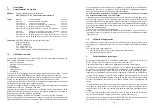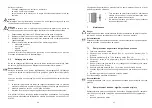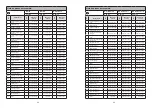
37
36
Adjustment of the Atomizing Air Pressure
The atomizing air pressure is adjusted at the air pressure reducing valve of the com-
pressor system. Please comply with the operating instructions and safety warnings
issued by the manufacturer.
If you wish to change the spraying pattern beyond the adjustments outlined so far,
you must retool the spray gun (See
5.6 Retooling of Spray Gun
).
WALTHER offers a great variety of air cap/-material nozzle/needle combinations for
this purpose.
5.5
Correcting of Spray Pattern Imperfections
The following table shows what to do to correct a spray pattern.
Spray pattern test
Fault
Required adjustment
Spray pattern is split in the
centre
• setting a wider spray pattern
Spray pattern is too thick at
the ends
• Setting a more rounded spray
pattern
The spray pattern shows
rather large droplets
• Increase the nozzle air pressure
Material application in the
centre of the spray pattern is
very thin
• Decrease the nozzle air pressure
Spray pattern is split in
the centre
• Increase the nozzle diameter
• Reduce nozzle air pressure
• Increase material pressure
Spray pattern is very spheri-
cal
• Reduce material pressure
• Increase nozzle air pressure
5.6
Retooling of Spray Gun
Combinations of air cap, material nozzle and needle, designed to match specific
spraying media types and grades, form a unit - namely the nozzle insert assembly.
In order maintain the desired spray-finish quality standard always replace the com-
plete nozzle insert assembly.
Warning
Prior to retooling: Make sure that the spray gun is in unpressurized condition, i.e. all
air and material inputs must be shut off - if not, imminent risk of injury.
Notice
In order to perform the following procedures please use the drawing at the beginning
of these operating instructions.
Replacement of Air Cap
1. Unscrew the knurled air cap retaining ring in (item 1) from the front body (Item 7).
2. Pull the air cap (item 2) of the front body.
3. Position the required air cap on the front.
4. Screw the air cap retaining ring in (item 1) onto the front.
Replacement of Material Control Nozzle and Needle
1. Remove the air control head (item 2) (see
5.6 Replacement of Air Control Head
).
2. Unscrew the material nozzle in (item 3) from the front (item 7) (width over flats
of hex. nut 13).
3. Pull out the pulling rod (item 26) together with the material needle (item 23).
4. Unscrew the cap in (item 25) from the threaded ring in (item 22) and remove the
needle spring (item 24).
5. Pull the material needle (item 23) out of the piston housing (item 18).
Installation of the new nozzle insert assembly and the remaining parts is performed
in the reverse order.
Notice
The needle setting for the PILOT WA 705 - 755 is x = 91 mm and for the PILOT
WA 708 - 738 adhesive x = 98,5 mm from the needle tip to the driving tenon.
6 Cleaning
6.1
Safety Warnings
•
Prior to any servicing and repair work: Make sure that the spray gun is in unpres-
surized condition, i.e. all air and material inputs must be shut off - if not, immi-
nent risk of injury.
•
No open fires, naked light and smoking allowed in the work area. When spraying
readily flammable media such as cleaning solutions, there is an increased risk
of fire and explosion.
•
Observe the safety warnings issued by the manufacturer. Aggressive and corro-
sive media represents risks and hazards to personal health.
6.2
Cleaning - Complete
Regular cleaning and lubrication of the spray gun has to be performed, in order to
increase the service life and the function of the spray gun.
Clean the gun only with cleaning solutions recommended by the manufacturer of the
spraying material used at the time. It is important to make sure that cleaning soluti-
ons do not contain any of the following constituents:
•
halogenated hydrocarbons (e.g. 1,1,1-trichloroethane, methylene chloride, etc.)
•
acids and acidiferous cleaning solutions
•
regenerated solvents (so-called cleaning dilutions)
•
paint removers.
The above constituents cause chemical reactions with the electroplated components
resulting in corrosion damage. WALTHER Spritz- und Lackiersysteme is not respon-
sible for any damages resulting from such treatment.
desired spray result
x
















































